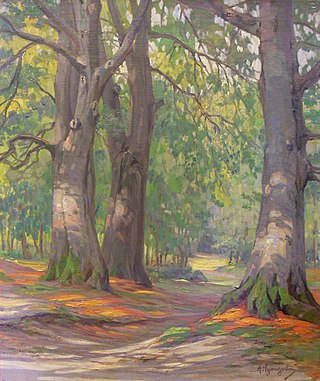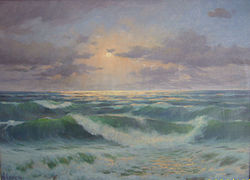Top Qs
Timeline
Chat
Perspective
Arnold Lyongrün
German painter From Wikipedia, the free encyclopedia
Remove ads
Ernst Arnold Lyongrün (1871–1935) was a German practitioner of the Jugendstil or Art Nouveau style of decorative arts and a painter in the Impressionistic mode.


Early life
Lyongrün was born Oct. 2, 1871, in Domnau, Province of Prussia (now Domnovo, Russia). He grew up during the Gründerzeit boom of Imperial Germany, studying in Königsberg (now Kaliningrad, Russia) and at the Staatliche Akademie für Kunst und Kunstgewerbe Breslau (now Wrocław, Poland). Thereafter he studied at the Académie Julian in Paris under French artists Jules Joseph Lefebvre and Tony Robert-Fleury, and undertook student journeys around France, Austria and Italy.
Beginning in 1898, Lyongrün lived and worked in the Hamburg area, and in 1907 he became a teacher at the State Academy of Art in Hamburg. During the First World War he was drafted into the Germany Army. Lyongrün survived the war and in 1919 became an independent painter. He became a member of the Hamburg Artists Society (founded 1920) and subsequently a member of the German National Association of Visual Artists (Reichsverband Bildender Künstler Deutschlands). A few years later he was a member of the artists colony at Ahrenshoop on the Darss Peninsula at the Baltic Sea, in Hither Pomerania.[1][2]
Remove ads
Career
During his sojourn in France, the young Lyongrün was inspired by the Art Nouveau movement exemplified by the École de Nancy ("School of Nancy"). He published a number of patterns for decorative arts and crafts, among them Decorative Motifs from the Natural World (1899) and New Ideas for Decorative Art (1901).[3] These works are held by the Metropolitan Museum of Art, New York.
In art history, Lyongrün is regarded primarily as a landscape painter and a marine artist. His paintings include scenes from the Black Forest, the Lüneburg Heath, the low-lying environs of Hamburg and the shores of the Baltic Sea. He also painted a few portraits. Early exhibitions of Lyongrün's works were staged in Hamburg in 1911 and 1919.
Remove ads
Gallery
- Spring on the Lühe (1904)
- The Blooming Heath (1910)
- Feldberg, Black Forest (1910)
- The Source (1911)
- Mill on the Titisee (1912)
- Oaks on the Kellersee (1919)
- Evening on the Baltic (1921)
- Heath Landscape near Wilsede
- Baltic Sea Surf (1925)
- Track, Lüneburg Heath
- Spring, Black Forest (1912)
References
Publications
Sources
External links
Wikiwand - on
Seamless Wikipedia browsing. On steroids.
Remove ads











